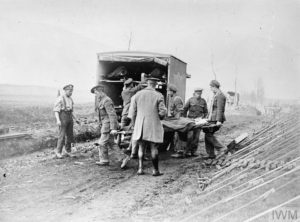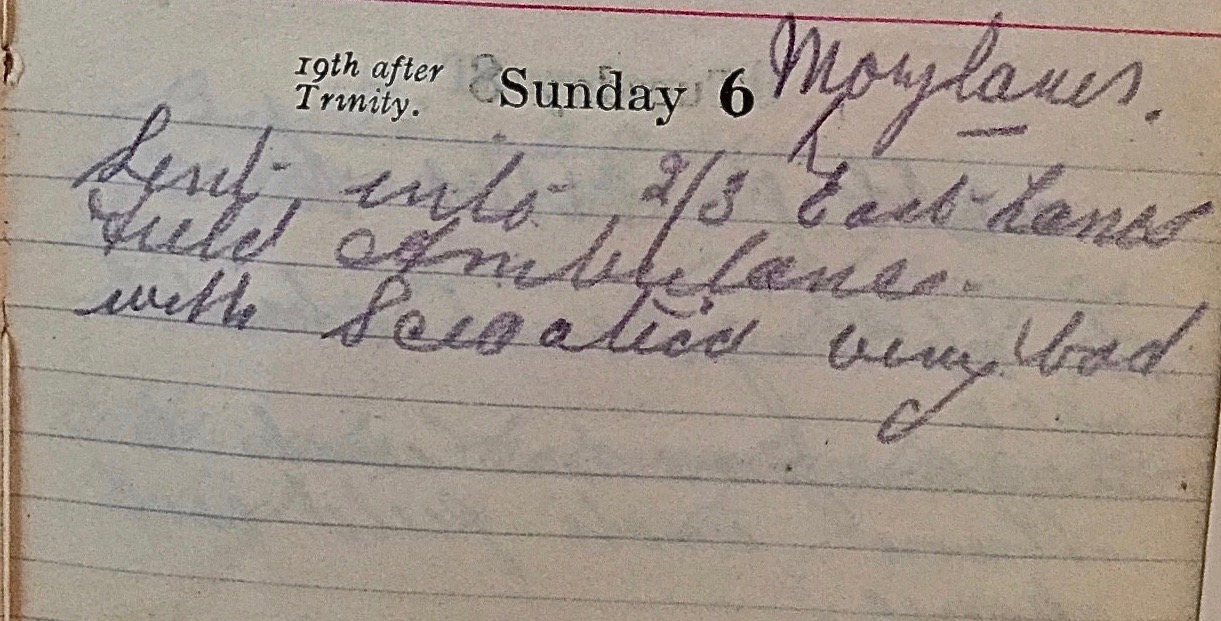Sunday October 6th, 1918
Moislains. Sent into 2/3 East Lancs Field Ambulance with sciatica – very bad.
To hospital
The Battalion is preparing to move to the front. However Frank, who couldn’t walk yesterday, has been diverted to hospital. He has been suffering from this ailment on and off since he was in Salonica earlier this year.
He calls it ‘sciatica’ now and referred to it as ‘rheumatics’ in earlier diary entries. It is something that will continue to haunt him back in civilian life and he will be in and out of hospital for many years. In the mid-1920s, he will have his leg fused straight and will walk with a limp and the aid of a cane for the rest of his life.
But today, it means he will go to the Field Ambulance for treatment and miss the Battalion’s advance to the Front.
The 2/3rd East Lancs Field Ambulance was originally raised in the Manchester area of the UK and has been working in support of the 66th Division. The following War Diary entry for this Field Ambulance illustrates both the structure and fluidity of front line hospital services in WWI. For more general information link here to an earlier post.
2/3rd East Lancs Field Ambulance (2/3rd ELFA)
In early March 1918, the 66th Division went up the line to relieved the 24th Division. Therefore 2/3rd ELFA moved with the 197 Infantry Brigade, taking over ‘forward evacuation‘ from the 73rd Field Ambulance at Bernes.
As such they were involved at the sharp end of Germany’s Spring Offensive when it began on March 21st 1918. Their War Diary entry for 6:10am that morning read:

‘Order received from ADMS 66th Division ‘Prepare for Battle’. This was passed on to officers in charge of ADS Templeux and Jeancourt and the personnel at these dressing stations was reinforced. In addition twenty bearers were sent from 2/2nd ELFA to ADS Templeux . Preparations were made to receive wounded and the Gas Centre was opened up. Walking Wounded Collecting Post was opened at Montigny Farm under Capt White and Capt Bounds and was equipped with medical stores and comforts.’
‘6:45am: Gas casualties began to arrive shortly followed by battle casualties of all sorts of which there was a steady stream of ?? throughout the day. These were mainly collected from Hervilly, Hesbecourt and from battery positions throughout the whole divisional area. The sick remaining in the Main Dressing Station were evacuated Corps Rest Station at Doingt by horse ambulance. The neighbourhood of the ADS Templeux was very heavily shelled and it was difficult to maintain communication with the posts in the forward area.
The photograph shows the 43rd Casualty Clearing Station in Frevent during Germany’s Spring Offensive. Stretcher cases are being put onto a motor ambulance.*
Later in the Day

About noon the MOs attached to the 5th Border Regiment, 4th East Lancs Regt and 2/5th East Lancs Regiment fell back in Templeux ADS and the MOs in charge of Templeux ADS opened up the reserve ADS at the Hesbecourt-Roisel-Templeux cross road. This was completed at 3:30pm. All equipment and medical stores were removed in two limber GS wagons under Capt JH Bounds. Relays of stretcher bearers were left to maintain communication with Templeux.
Later in the day, the Advanced Dressing Station was withdrawn to a site in Roisel, recently evacuated by the 2/2 East Lancs Field Ambulance.
From Jeancourt ADS all cases were evacuated by cars of the Field Ambulance direct to Bernes. This ADS became untenable at 6:30pm and the MO and personnel with the bulk of the equipment were withdrawn to Montigny Farm where a new ADS was formed in conjunction with the Walking Wounded Post. …
57 officers of whom 6 were gassed cases were admitted during the day. 769 OR of whom 278 were gassed were admitted during the day.’¹
The map shows the various locations mentioned in the Diary, the distance from Templeux to Bernes was ~15 kms. You will notice that these locations were close to the Hindenburg Line, which ran south through St Quentin.
Clearly, Frank is in good hands.
9th Battalion War Diary – 6th October 1918 – Moislains to Templeux-la-Fosse
Battalion organized and prepared to move.
References & Further Reading
¹ The War Diary 2/3rd East Lancashire Field Ambulance for March, 1918
* Q 336, copyright Imperial War Museums
^ © Google Maps


